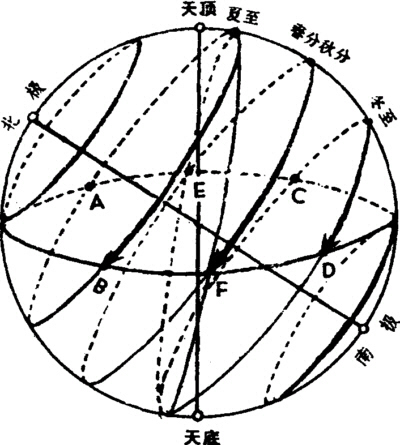Chapter 56 Chapter Two
In explaining astronomical phenomena, the Huntian theory seems to be superior and has won many supporters.
Zhang Heng expounded the main idea of the theory of the armillary sphere in "Notes on the Armillary Sphere": the sky is a spherical shell, and the sky encloses the earth, like an eggshell enclosing the yolk.Outside the sky is gas, inside the sky is water, and the earth floats on the water.The whole day is 3601/4 degrees, half of which is covered on the ground, and half is surrounded by the ground, so only half of the twenty-eight stars can be seen.The South Pole and the North Pole are separated by a full half circle.The sky is spinning like a wheel, showing no sign of stopping.
Analyzing the armillary sphere and armillary phenomena made by the armillary family will help readers understand the ability of the armillary theory in explaining astronomical phenomena.As shown in Figure 22, there are five circles perpendicular to the polar axis.The circle near the North Pole is called the constant display circle, and the stars in the circle are always above the ground throughout the year.The circle near the South Pole is called the Hidden Circle. The stars in the circle are always below the ground and cannot be seen throughout the year.The circle in the middle represents the celestial equator.During the spring and autumn equinoxes, the sun moves along the celestial equator, originating from point E in the due east, and sinking in point F in the due west, and the distance traveled by day and night is equal.The north of the celestial equator is the orbit that the sun walks on the summer solstice. It starts at point A in the northeast in the morning and ends at point B in the northwest in the evening. The distance traveled during the day is significantly longer than that at night.Not only that, but the armillary sphere can also quantitatively express the data that is completely consistent with the real celestial phenomenon.

Figure 22 Explanation diagram of the theory of the sky
The celestial phenomena that Gaitian said can be demonstrated can also be demonstrated by Huntian.Gaitian said that the celestial phenomena that cannot be demonstrated can be demonstrated by Huntian.It seems that the theory of Huntian is impeccable in expressing the visual movement of celestial bodies.However, it was difficult for the ancients to accept the assumption that the sun, the moon, and the stars would be immersed in water at night, so that the dispute between the theory of Huntian and the theory of Gaitian persisted for a long time until the Tang Dynasty.
It must be mentioned here that in the process of quantifying Gaitian theory, two geometric theorems and a hypothesis were used to draw a series of conclusions.The two geometric theorems are: (1) The corresponding sides of similar triangles are proportional. (2) Pythagorean theorem of right triangle.One hypothesis is: measure the shadow length at the same time with the eight-foot meter in the north and the south, and if the distance is 1,000 miles, the shadow length should differ by one inch.The problem lies in this assumption.However, not only the Gaitians believed in it, but even the Huntianists Zhang Heng, Ge Hong, Zu Wei, etc. also regarded it as an axiom and used it as a basis for inference.
In the twelfth year of Tang Kaiyuan (AD 724), Yiyi and Nangong Shuo and others measured the shadow length in Huaxian County, Junyi (now Kaifeng), Fugou and Shangcai in Henan, and found that Huaxian was 526.9 miles away from Shangcai. , but the difference in shadow length is 2.1 inches, which completely negates the hypothesis that "the difference between the sun's shadow and the shadow of a thousand miles is one inch".
After this famous argument, the theory of Huntian became convinced by the vast majority of people and became the orthodox theory of the universe in ancient China.

Figure 22 Explanation diagram of the theory of the sky
